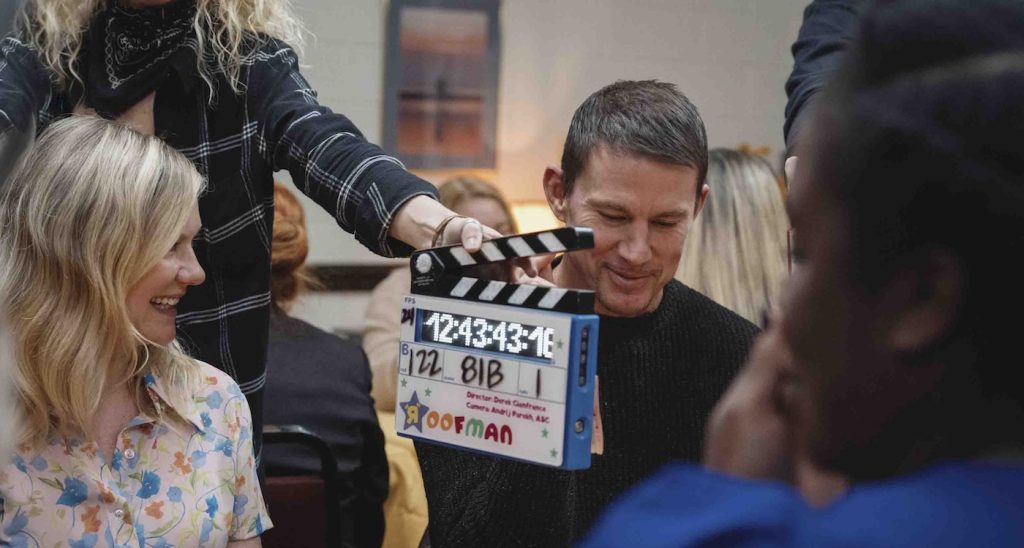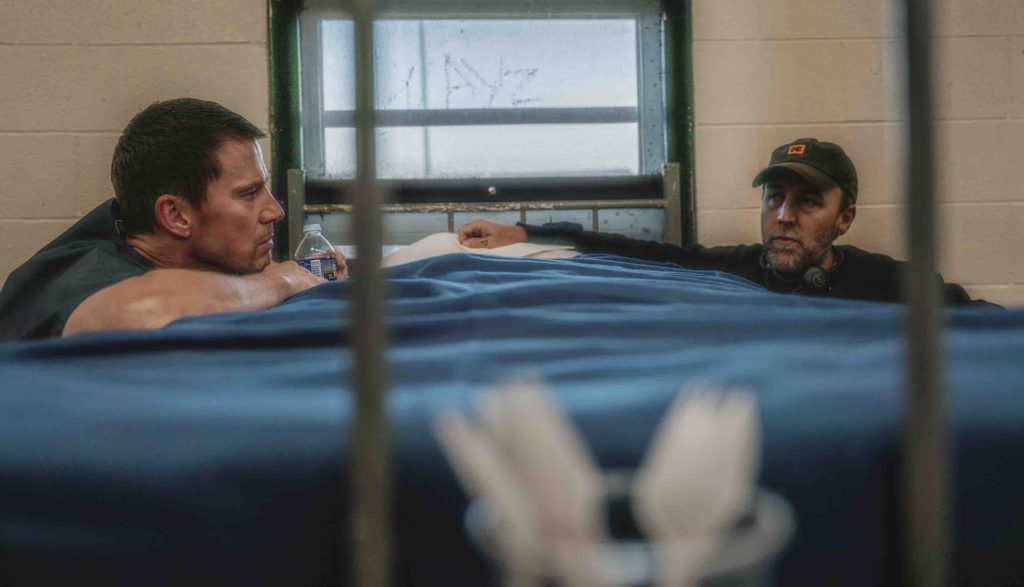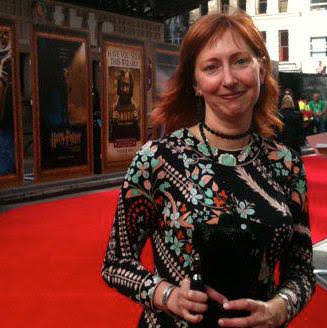“Roofman” Writer/Director Derek Cianfrance on Casting Real People from Jeffrey Manchester’s Incredible True Story
The real story behind co-screenwriter and director Derek Cianfrance’s new feature Roofman (co-written with Kirt Gunn) is almost too bizarre to believe. In the late 1990s, North Carolina, a financially strapped father and army veteran, Jeffrey Manchester, broke into 45 McDonald’s locations by cutting through their roofs at night, robbing the employees at gunpoint in the morning. He gained the nickname Roofman, but was also famously very polite and kind to the employees, even giving up his coat to someone he was putting in the walk-in freezer. The police caught Manchester, and he was sent to prison for a 45-year sentence. Then, he escaped from prison and hid in a Toys R Us for months by building an enclosure for himself behind a bike display. Over the time he was in hiding, he started attending and giving toys to a local church, and even dated someone he met in bible study there. Eventually caught again, he is now serving his sentence through 2036.
Cianfrance, known for his films Blue Valentine and A Place Beyond the Pines, cast Channing Tatum as Manchester and Kirsten Dunst as Leigh Wainscott, the woman he met and dated after escaping from prison. Roofman is a story full of heart and heartbreak, narrated by Tatum, who uses many words taken directly from Manchester himself. The Credits spoke to Derek Cianfrance about the experience of adapting this extraordinary true-life tale for the big screen.
Between 1998 and 2010, you worked on documentaries. What aspects of documentary work were the most helpful or present for you in creating and bringing Roofman to the screen?
With documentaries, I learned to become humble as a filmmaker. I grew up with the idea of a filmmaker as Cecil B. DeMille, a director with a megaphone shouting his or her orders to the world, and with documentaries that didn’t resonate with me. I noticed that I had to set the megaphone to my ear, and it was a way to funnel in the world and listen. If I were shooting a documentary and following someone around, they could pick a chair that was in the darkness, or the chair could break, and I wouldn’t be able to get a second take. So, I had to be very watchful and present. I had to listen and be on my toes. Once I got to make narrative features again, I just tried to bring all those elements of listening and presence back into those narrative features, because now I was working with great actors. I just wanted to treat them as regular people, and surround them with regular people in a sort of documentary world.

How is that exemplified in Roofman?
For Jeff’s story and our film, I shot it in Charlotte, North Carolina, where the events took place, using many of the real locations, including the church and the courtroom where he was sentenced. Then I tried to surround him with as many people from the real situation as possible, so that they could also validate and act as professionals in the scene, allowing my actors to be dropped into this aquarium of real life. They’re no longer faking it. They’re acting in the true way. When I was doing documentaries, I realized that these people are in action and they’re telling the truth, so why can’t I have actors do the same thing?
So you cast real people like Jeff’s real arresting officer, Katherine Scheimreif, as Sally, the retired cop at the singles brunch. Why was that important to you, and what did they bring to the film?
It was important to me because this story is so unbelievable; I wanted just to ground myself in truth. I feel like the keys to any movie are to keep the suspension of disbelief and persistence of vision, at least for narrative films. I find I need to suspend my own disbelief while I’m on set, so I just had to have a way to believe the story myself. Going down there to these environments with the real people, and hear from them that ‘Yes, this is what happened,’ really helped. Having Katherine Scheimreif, for example, at Red Lobster, made Channing nervous, which was great because I wanted someone who could smell the BS on him and make him sweat a little. Also, having these real people part of the production makes it like a homecoming. I always saw this movie as one of those Christmas movies, which are inherently nostalgic, but I think they’re also about a return home. They often take place in a small town where a big event happens and brings everyone together. This was a big event in Charlotte 20 years ago when it happened, and I just felt the need to go down there with the people who it had happened to, and let them relive it, maybe to have some personal catharsis with it or confront it.
You cast other folks, too, like Leigh Moore, who Kirsten Dunst portrays in the movie. She has a cameo as a school crossing guard, and Pastor Ron Smith plays the pawnshop employee.
Right. Some people said no, they didn’t want to be a part of it, but the people that did, I wanted them to make it with us, because the last thing I wanted to be part of was Hollywood coming to town to tell the inauthentic version of the story. I wanted them to all be proud of the movie and engage with their memories in a kind of playful way, honestly, which is why I didn’t always cast everyone as themselves. I wanted them to create other characters so that they could have a new perspective on the events. And it was a homecoming for me, too. The first time I went down to Charlotte, I was scouting for a fast-food restaurant. I went into a Popeyes’ chicken, and the manager embraced me, brought me into the kitchen, and invited me over for dinner. It made me think this is the community that would welcome this stranger in off the street and truly embrace him.
You not only met Jeffrey Manchester, you spent hundreds of hours speaking to him over the course of writing the script and the production. What is an example of an illuminating conversation that led to what we see onscreen?
There were so many conversations that meant something to me with Jeff. He has this huge heart, but he is heartbroken as well. One of the stories that really resonated with me about Jeff is that he spent nine years in solitary confinement after the events depicted in this movie, and when I spoke with him, he was incredibly optimistic. I asked him how he survived those nine years, and he said, “I filled houses. I would imagine I had $100,000, and I would think of what I could build for my family with that money, and I filled every room. All my kids had a room. I knew what the fixtures were like on the sink, and I knew what the hinges were like on the doors. I would memorize and live in these houses. It would take me six months to fully build this $100,000 house, and when I was done with that, I would give myself a million dollars and imagine I was making a million-dollar house, and I’d have a pool and a three-car garage”. He lived in these homes, and I realized that here was a guy dreaming of homes. That’s why he started robbing McDonald’s in the first place: to build a home, but then he got his home taken away. This story is, in part, one man’s search for home. Then I started to realize that Roofman is what they called him on the news, but Roofman also reminded me of what my father used to tell me, which is “I put a roof over your head.” I was thinking that Roofman is Jeff’s story about mixing up what it means to be a father and what it means to be a provider. The opening shot of the movie pans across a shopping center in the middle of the night called “Homemaker.” That all came from Jeff’s desire for home.

Roofman is currently in theaters nationwide.
Featured image: Channing Tatum stars in Paramount Pictures’ “ROOFMAN.”



